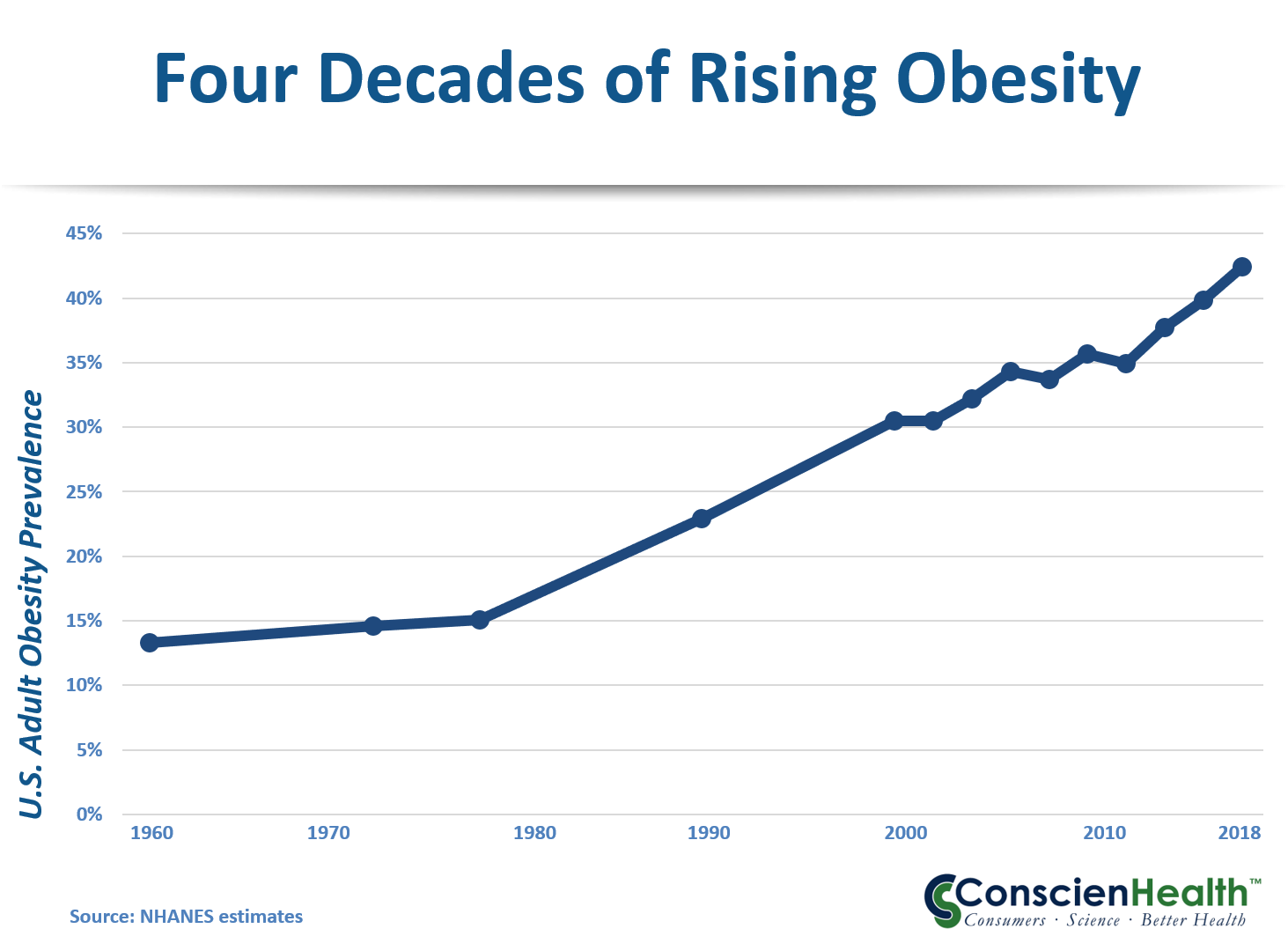
Obesity Prevalence: Up, Up, and Away
 Here we go again. New data from CDC on obesity prevalence gives us more of the same bad news we’ve been getting for decades. More rising prevalence. The rate of adult obesity in the U.S. rose above 40 percent for the first time ever, reaching 42.4 percent in 2018. For severe obesity, the prevalence is rising even faster. It’s now 9.2 percent, almost double what it was in 2000. The 2018 number for severe obesity represents a 19 percent increase in the number of adults with severe obesity since 2016.
Here we go again. New data from CDC on obesity prevalence gives us more of the same bad news we’ve been getting for decades. More rising prevalence. The rate of adult obesity in the U.S. rose above 40 percent for the first time ever, reaching 42.4 percent in 2018. For severe obesity, the prevalence is rising even faster. It’s now 9.2 percent, almost double what it was in 2000. The 2018 number for severe obesity represents a 19 percent increase in the number of adults with severe obesity since 2016.
The response was a bit of a yawn. CDC and the media are busy with the coronavirus. The Associated Press went to our friend Bill Dietz for perspective and reported as follows:
Dietz faulted the government for not pushing for more measures to promote physical activity and better eating. Building more sidewalks and passing a national tax on sugary beverages could make a big difference, he said.
Sidewalks Would Help
Indeed, over time, more sidewalks would be a good thing. In many communities, walking is not really a practical way to get around. But it should be the preferred method. Sidewalks are important and yet they’re just one of many factors in our built environment that are conspiring to prompt more obesity in the people who are susceptible.
Will more sidewalks help? Probably so. However, it’s not at all clear that they would make a “big difference.” Nor is it clear that a national soda tax would make a big difference. For two decades now, people in the U.S. have been cutting back on sugar consumption. If that’s made a difference in obesity prevalence, it’s certainly not obvious.
What Would Really Help?
The truth is that this is a wicked problem. For four decades now, people have been full of glib answers based on incomplete information and many false assumptions. At one time we thought cutting fat was the answer. Now, we’re busy cutting carbs. Sidewalks are good. How about more breastfeeding? We’ve got to deal with food addiction! Food marketing is the devil’s work that’s making us all fat!
These are all compelling narratives. But in truth, what we really need is more objectivity to admit what we don’t know about obesity. We need to muster more curiosity to figure it out and find interventions that really work – both for treatment and prevention. And most of all, we need better care for the people affected, free from stigma and blame.
Obesity is us. We are now 42 percent of the population. Our health is at stake.
Click here for the CDC report. They didn’t even bother with a press release, but you can find more from the Associated Press here.
Up and Up, photograph © Cristian Roberti / flickr
Subscribe by email to follow the accumulating evidence and observations that shape our view of health, obesity, and policy.
February 28, 2020

February 28, 2020 at 5:39 pm, Allen Browne said:
Yup! Research with an open mind, a careful look at evidence so far, and thoughtful consideration of clues would go a long way.
Allen
February 28, 2020 at 11:35 pm, David Brown said:
“We need to muster more curiosity to figure it out and find interventions that really work – both for treatment and prevention.”
There are interventions that really work.
http://www.buttermakesyourpantsfalloff.com/lard-makes-you-lean/
https://spudfit.com/
https://christinecronau.com/
Problem is, scientists get distracted with all sorts of details unrelated to the cause of the obesity epidemic. https://www.ncbi.nlm.nih.gov/pubmed/25673413
February 29, 2020 at 6:28 am, Mary-Jo said:
At this point, enough IS known that obesity is a multicomponent disease and depending on the individual or community, one or more of the factors may be involved. Thus, it IS challenging to diagnose and treat. But, we know quite a bit about what DOES work! It’s just not being done! Weight stigma and bias perpetuates ignorance and lack of will to provide access to and implement best care.
February 29, 2020 at 3:11 pm, Neil Robert Floch MD FACS said:
Cumulative evidence from multiple studies leads us to believe that obesity is due to environmental exposure to 85% of people who are genetically susceptible to developing obesity. The rising trend of obesity will continue unless governments heed the call to take action on limiting exposure of citizens to unhealthy foods: highly processed, sugar-containing, as well as those high in simple carbohydrates to name a few. Policy changes such as sugar-taxes have shown positive evidence. We need to also continue to identify, isolate and take action on other substances in or in contact with our food supply that are leading to obesity and other chronic diseases.
March 08, 2020 at 6:57 pm, Angus said:
“Policy changes such as sugar-taxes have shown positive evidence.”
Really?
March 09, 2020 at 4:07 am, Ted said:
Angus, I think the positive evidence for sugar taxes is the unsurprising observation that when we tax SSBs, their consumption goes down. The problem is that we don’t have any evidence for a health benefit. As we’ve noted here before, we’re quite skeptical about assuming there is a net benefit: https://conscienhealth.org/2019/05/philly-obesity-soda-tax/